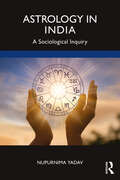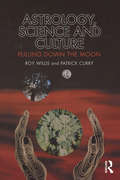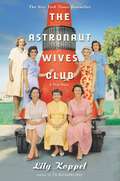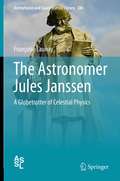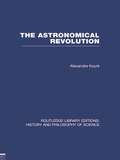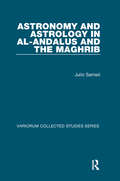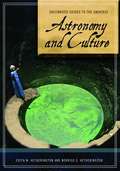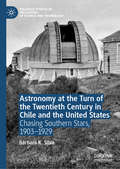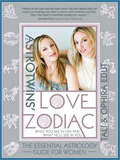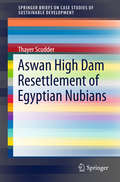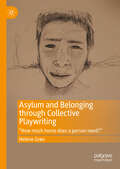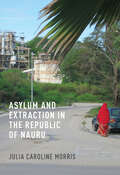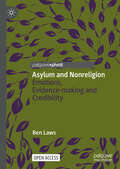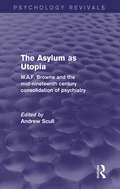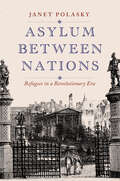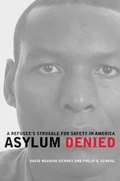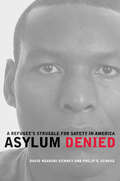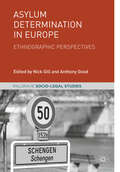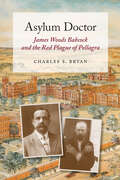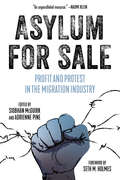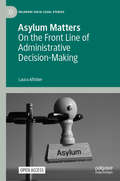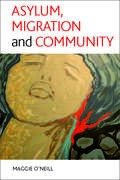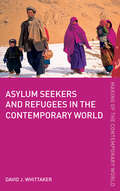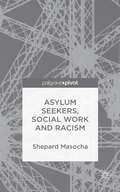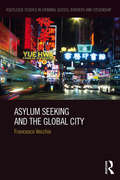- Table View
- List View
Astrology in India: A Sociological Inquiry
by Nupurnima YadavThis book critically examines the larger world of astrology in India, its ubiquity and relationship with religion, caste, gender, class and aspirations. It looks at astrology through an empirical and phenomenological lens, analyzing different meanings and questions associated with it. How do people see astrology—as magic, science, religion, or a knowledge system? The volume analyses the role of astrology in religious and social ceremonies; the interplay of faith and fear; beliefs, practices, mysticism, and skepticism in middle-class households; and gendered negotiations in everyday life. It also delves into how astrology has emerged as a livelihood and an industry, the continued fascination with it even in an era of technological advancement, and its domination of the vernacular media. Insightful and highly comprehensive, this book will be useful for scholars and researchers of sociology, political sociology, social anthropology, anthropology, cultural studies, gender studies and urban Sociology.
Astrology, Science and Culture: Pulling down the Moon
by Roy Willis Patrick CurryMainstream science has long dismissed astrology as a form of primitive superstition, despite or perhaps even because of its huge popular interest. From daily horoscopes to in-depth and personalized star forecasts, astrology, for many, plays a crucial role in the organization of everyday life. Present-day scholars and scientists remain baffled as to why this pseudo-science exercises such control over supposedly modern, rational and enlightened individuals, yet so far they have failed to produce any meaningful analysis of why it impacts on so many lives and what lies behind its popular appeal. Moving beyond scientific scepticism, Astrology, Science and Culture finally fills the gap by probing deeply into the meaning and importance of this extraordinary belief system. From the dawn of pre-history, humankind has had an intimate connection with the stars. With its roots in the Neolithic culture of Europe and the Middle East, astrology was traditionally heralded as a divinatory language. Willis and Curry argue that, contrary to contemporary understanding including that of most astrologers astrology was originally, and remains, a divinatory practice. Tackling its rich and controversial history, its problematic relationship to Jungian theory, and attempts to prove its grounding in objective reality, this book not only persuasively demonstrates that astrology is far more than a superstitious relic of years gone by, but that it enables a fundamental critique of the scientism of its opponents. Groundbreaking in its reconciliation of astrologys ancient traditions and its modern day usage, this book impressively unites philosophy, science, anthropology, and history, to produce a powerful exploration of astrology, past and present.
The Astronaut Wives Club: A True Story
by Lily KoppelDiscover the true story of the women who stood beside some of the greatest heroes of American space travel. <p><p> As America's Mercury Seven astronauts were launched on death-defying missions, television cameras focused on the brave smiles of their young wives. Overnight, these women were transformed from military spouses into American royalty. They had tea with Jackie Kennedy, appeared on the cover of Life magazine, and quickly grew into fashion icons. <p><p> Annie Glenn, with her picture-perfect marriage, was the envy of the other wives; JFK made it clear that platinum-blonde Rene Carpenter was his favorite; and licensed pilot Trudy Cooper arrived with a secret that needed to stay hidden from NASA. Together with the other wives they formed the Astronaut Wives Club, providing one another with support and friendship, coffee and cocktails. <p><p> As their celebrity rose—and as divorce and tragedy began to touch their lives—the wives continued to rally together, forming bonds that would withstand the test of time, and they have stayed friends for over half a century.
The Astronomer Jules Janssen
by Françoise LaunayA physicist and an inventor, Jules Janssen (1824-1907) devoted his life to astronomical research. He spent many years traveling around the world to observe total Solar eclipses, demonstrating that a new era of science had just come thanks to the use of both spectroscopy and photography, and persuading the French Government of the necessity of founding a new observatory near Paris. He became its director in 1875. There, at Meudon, he began routine photographic recordings of the Sun surface and had a big refractor and a big reflector built. Meanwhile, he also succeeded in building an Observatory at the summit of Mont-Blanc. The story of this untiring and stubborn globe-trotter is enriched by extracts of the unpublished correspondence with his wife. One can thus understand why Henriette often complained of the solitude in which she was left by her peripatetic husband: "There are men who leave their wives for mistresses; you do it for journeys!" ... Basking in the glow of his success, Janssen was able to undertake the construction of the great astrophysical observatory of which he had dreamed. It was at Meudon that he had it built.
The Astronomical Revolution: Copernicus - Kepler - Borelli (Routledge Library Editions: History & Philosophy of Science)
by Alexandre KoyreOriginally published in English in 1973. This volume traces the development of the revolution which so drastically altered man’s view of the universe in the sixteenth and seventeenth centuries. The "astronomical revolution" was accomplished in three stages, each linked with the work of one man. With Copernicus, the sun became the centre of the universe. With Kepler, celestial dynamics replaced the kinematics of circles and spheres used by Copernicus. With Borelli the unification of celestial and terrestrial physics was completed by abandonment of the circle in favour the straight line to infinity.
Astronomy and Astrology in al-Andalus and the Maghrib
by Julio SamsóThis new volume of papers by Julio Samsó deals with the development of astronomy and astrology in al-Andalus and the Maghrib between the 10th and the 19th centuries. Opening with a survey of the social history of the exact sciences in al-Andalus, the book then looks at astronomical tables: the first stages of the introduction of al-Khwarizmi's and al-Battani's tables through the school of Maslama al-Majriti, the development of Ibn al-Zarqalluh/ Azarquiel's theories in Maghribi zijes (Ibn al-Banna' and Ibn Azzuz) and the abandonment of this tradition towards the end of the 14th century. From this period onwards new Eastern zijes (Muhyi al-Din al-Maghribi, Ibn al-Shatir, Ulugh Beg) are introduced in the Maghrib and, towards the beginning of the 17th century, a translation of Abraham Zacut and José Vizinho's Almanach Perpetuum (end of the 15th century) becomes well known in the whole Islamic world, from Morocco to the Yemen. As well as zijes themselves, the author also deals with theoretical astronomy (the use of an elliptical deferent for Mercury in Ibn al-Zarqalluh's equatorium and the criticisms of Ibn al-Haytham and Jabir b. Aflah on Ptolemy's determination of the parameters of the same planet), and with the use of zijes for the calculation of horoscopes, and an experimental astrological method for the correction of mean motion planetary tables (Ibn Azzuz).
Astronomy and Culture
by Edith W. Hetherington Norriss S. HetheringtonE. Hetherington, a former second language teacher and attorney, has paired with N. Hetherington (director, Institute for the History of Astronomy) to explore the relationship between astronomy and culture throughout history in the face of contradictory attitudes from the scientific community. This book introduces the discipline of archaeoastronomy to students and scholars by reviewing ancient mythologies about the universe, revealing Babylonian concepts of astronomy, charting the development of calendars and documenting the Copernican and Newtonian Revolutions. The authors also discuss the precarious relationship between religion and astronomy such as the debate between creationism and evolution. Annotation ©2009 Book News, Inc., Portland, OR (booknews.com)
Astronomy at the Turn of the Twentieth Century in Chile and the United States: Chasing Southern Stars, 1903–1929 (Palgrave Studies in the History of Science and Technology)
by Bárbara K. SilvaThis Palgrave Pivot tells the transnational story of the astronomical observatory in the hills near Santiago, Chile, built in the early twentieth century through the efforts of astronomers from the Lick Observatory in California. Venturing abroad to learn from largely unmapped Southern skies and, hopefully, answer lingering questions about the structure of the galaxy, they planned a three-year research expedition—but ended up staying for more than twenty-five years. The history of the Mills Expedition offers a window onto the history of astronomy, the challenges of scientific collaboration across national lines, and the political and cultural contexts of early-twentieth-century Chile and the United States.
The AstroTwins' Love Zodiac
by Tali Edut Ophira EdutDemystify men and transform any relationship. Discover what you see in him and what he'll see in you. The Astro Twins have been using the zodiac for over 15 years to help couples find the love affair of their dreams. A good relationship may mean adjusting to someone who often thinks, acts, and views the world in a way totally foreign to you. You can have a great relationship with a man of any zodiac sign--the key is to learn what makes him tick. Using this definitive guide to understand his personality, his preferences, and his values will help you decide whether you're in it for the long haul--or not. Breaking down the entire astrological anatomy of all 12 signs of men, you'll quickly discover: How he courts, flirts, and shows he's committed; How to tell if he's serious or just playing around; What turns him on and off; How to prep for your first date, his first visit to your place, and meeting his family; What he values in life, a woman, and a relationship; Why he'd cheat and how to tell if he's serious or just playing around; When it's over for good; Commonly misunderstood signals; Your best moves; Sign-by-sign compatibility--what really happens in every combination, including the conflicts, the benefits, the compromises, and the ways you'll both grow from being together.
Aswan High Dam Resettlement of Egyptian Nubians (SpringerBriefs on Case Studies of Sustainable Development)
by Thayer ScudderThis book highlights the long-term resettlement process of the Egyptian Nubian people along the Aswan High Dam. Assessing the resettlement of 48,000 Egyptian Nubians in connection with the High Dam is especially important for three main reasons: firstly, this resettlement process is one of the rare cases in which research begun before the dam was built has continued for over forty years. Secondly, the resettlement of the Egyptian Nubian people is one of the few cases in which the living standards of the large majority improved because of the initial political will of the government, combined with Nubian initiatives. Thirdly, given the complexity of the resettlement process, weaknesses in government planning, implementation, and in the weakening of government political provide valuable lessons for future dam-induced resettlement efforts.
Asylum and Belonging through Collective Playwriting: "How much home does a person need?"
by Helene GrønThis book explores the notion of home in the wake of the so-called refugee crisis, and asks how home and belonging can be rethought through the act of creative practices and collective writing with refugees and asylum seekers. Where Giorgio Agamben calls the refugee ‘the figure of our time’, this study places the question of home among those who experience its ruptures. Veering away from treating the refugee as a conceptual figure, the lived experiences and creative expressions of seeking asylum in Denmark and the United Kingdom are explored instead. The study produces a theoretical framework around home by drawing from a cross-disciplinary field of existential and political philosophy, narratology, performance studies and anthropology. Moreover, it argues that theatre studies is uniquely positioned to understand the performative and storied aspects of seeking asylum and the compromises of belonging made through the asylum process.
Asylum and Extraction in the Republic of Nauru
by Julia Caroline MorrisAsylum and Extraction in the Republic of Nauru provides an extraordinary glimpse into the remote and difficult-to-access island of Nauru, exploring the realities of Nauru's offshore asylum arrangement and its impact on islanders, workforces, and migrant populations. Drawing on extensive fieldwork in Nauru, Australia, and Geneva, as well as a deep dive into the British Phosphate Commission archives, Julia Caroline Morris charts the island's colonial connection to phosphate through to a new industrial sector in asylum. She explores how this extractive industry is peopled by an ever-shifting cast of refugee lawyers, social workers, clinicians, policy makers, and academics globally and how the very structures of Nauru's colonial phosphate industry and the legacy of the "phosphateer" era made it easy for a new human extractive sector to take root on the island. By detailing the making of and social life of Nauru's asylum system, Morris shows the institutional fabric, discourses, and rhetoric that inform the governance of migration around the world. As similar practices of offshoring and outsourcing asylum have become popular worldwide, they are enabled by the mobile labor and expertise of transnational refugee industry workers who carry out the necessary daily operations. Asylum and Extraction in the Republic of Nauru goes behind the scenes to shed light on the everyday running of the offshore asylum industry in Nauru and uncover what really happens underneath the headlines. Morris illuminates how refugee rights activism and #RefugeesWelcome-style movements are caught up in the hardening of border enforcement operations worldwide, calling for freedom of movement that goes beyond adjudicating hierarchies of suffering.
Asylum and Nonreligion: Emotions, Evidence-making and Credibility
by Ben LawsThis open access Palgrave Pivot explores the experiences of nonreligious asylum seekers in Northern Europe. While religious persecution is often cited as a reason for seeking asylum, nonbelievers also face significant persecution in their home countries due to their lack of religious affiliation. Despite this, their experiences are frequently overlooked in academic discussions, and asylum assessment centers have been slow to develop frameworks that address their unique challenges. Drawing on in-depth qualitative research from Sweden, Norway, and the Netherlands, this book provides a comprehensive examination of the challenges nonbelievers face, as well as the opportunities they create as agents within the system. Emotions offer an analytical window into the world of nonbelievers, highlighting their desperation and innovative practices of evidence creation. Throughout the book, the logics of credibility assessment are critically explored, revealing the cultural chasm between assessors and nonreligious claimants.
The Asylum as Utopia: W.A.F. Browne and the Mid-Nineteenth Century Consolidation of Psychiatry (Psychology Revivals)
by Andrew ScullWhat Asylums Were, Are, and Ought to Be, first published in 1837, was of considerable significance in the history of lunacy reform in Britain. It contains perhaps the single most influential portrait by a medical author of the horrors of the traditional madhouse system. Its powerful and ideologically resonant description of the contrasting virtues of the reformed asylum, a hive of therapeutic activity under the benevolent but autocratic guidance and control of its medical superintendent, provided within a brief compass a strikingly attractive alternative vision of an apparently attainable utopia. Browne’s book thus provided important impetus to the efforts then under way to make the provision of county asylums compulsory, and towards the institution of a national system of asylum inspection and supervision. This edition, originally published in 1991 as part of the Tavistock Classics in the History of Psychiatry series, contains a lengthy introductory essay by Andrew Scull. Scull discusses the social context within which What Asylums Were, Are, and Ought to Be came to be written, examines the impact of the book on the progress of lunacy reform, and places its author’s career in the larger framework of the development of Victorian psychiatry as an organised profession. Through an examination of Browne’s tenure as superintendent of the Crichton Royal Asylum in Dumfries, Scull compares the theory and practice of asylum care in the moral treatment era, revealing the remorseless processes through which such philanthropic foundations degenerated into more or less well-tended cemeteries for the still-breathing – institutions almost startlingly remote from Browne’s earlier visions of what they ought to be.
Asylum between Nations: Refugees in a Revolutionary Era
by Janet PolaskyWhy some of the most vulnerable communities in Europe, from independent cities to new monarchies, welcomed refugees during the Age of Revolutions and prospered &“Janet Polasky unearths an unappreciated history of the experience of asylum in Europe and the United States since the Age of the Democratic Revolutions. Facing squarely the destruction of asylum in our own time, she ends with a stunningly optimistic vision of a path toward its reconstruction.&”—Linda K. Kerber, author of No Constitutional Right to Be Ladies Driven from their homelands, refugees from ancient times to the present have sought asylum in worlds turned upside down. Theirs is an age‑old story. So too are the solutions to their plight. In the wake of the American and French Revolutions, thousands of men and women took to the roads and waterways on both sides of the Atlantic—refugees in search of their inalienable rights. Although larger nations fortified their borders and circumscribed citizenship, two port cities, German Hamburg and Danish Altona, opened their doors, as did the federated Swiss cantons and the newly independent Belgian monarchy. The refugees thrived and the societies that harbored them prospered. The United States followed, not only welcoming waves of immigrants in the mid‑nineteenth century but offering them citizenship as well. In this remarkable story of the first modern refugee crisis, historian Janet Polasky shows how open doors can be a viable alternative to the building of border walls.
Asylum Denied: A Refugee's Struggle for Safety in America
by David Ngaruri Kenney Philip G. Schrag"Asylum Denied "is the gripping story of political refugee David Ngaruri Kenney's harrowing odyssey through the world of immigration processing in the United States. Kenney, while living in his native Kenya, led a boycott to protest his government's treatment of his fellow farmers.
Asylum Denied: A Refugee's Struggle for Safety in America
by David Ngaruri Kenney Philip G. SchragAsylum Denied is the gripping story of political refugee David Ngaruri Kenney's harrowing odyssey through the world of immigration processing in the United States. Kenney, while living in his native Kenya, led a boycott to protest his government's treatment of his fellow farmers. He was subsequently arrested and taken into the forest to be executed. This book, told by Kenney and his lawyer Philip G. Schrag from Kenney's own perspective, tells of his near-murder, imprisonment, and torture in Kenya; his remarkable escape to the United States; and the obstacle course of ordeals and proceedings he faced as U.S. government agencies sought to deport him to Kenya. A story of courage, love, perseverance, and legal strategy, Asylum Denied brings to life the human costs associated with our immigration laws and suggests reforms that are desperately needed to help other victims of human rights violations.
Asylum Determination in Europe: Ethnographic Perspectives (Palgrave Socio-Legal Studies)
by Nick Gill Anthony GoodDrawing on new research material from ten European countries, Asylum Determination in Europe: Ethnographic Perspectives brings together a range of detailed accounts of the legal and bureaucratic processes by which asylum claims are decided. The book includes a legal overview of European asylum determination procedures, followed by sections on the diverse actors involved, the means by which they communicate, and the ways in which they make life and death decisions on a daily basis. It offers a contextually rich account that moves beyond doctrinal law to uncover the gaps and variances between formal policy and legislation, and law as actually practiced. The contributors employ a variety of disciplinary perspectives – sociological, anthropological, geographical and linguistic – but are united in their use of an ethnographic methodological approach. Through this lens, the book captures the confusion, improvisation, inconsistency, complexity and emotional turmoil inherent to the process of claiming asylum in Europe.
Asylum Doctor: James Woods Babcock and the Red Plague of Pellagra
by Charles S. BryanThis biography of an early twentieth-century South Carolina doctor sheds light on his pioneering work with the mentally ill to combat a public health scourge.Thousands of Americans died of pellagra before the cause—vitamin B3 deficiency—was identified. Credit for solving the mystery is usually given to Dr. Joseph Goldberger of the US Public Health Service. But in Asylum Doctor, Charles S. Bryan demonstrates that a coalition of American asylum superintendents, local health officials, and practicing physicians set the stage for Golberger’s historic work—chief among them was Dr. James Woods Babcock.As superintendent of the South Carolina State Hospital for the Insane from 1891 to 1914, Babcock sounded the alarm against pellagra. He brough out the first English-language treatise on the subject and organized the National Association for the Study of Pellagra. He did so in the face of troubled asylum governance which, coupled with Governor Cole Blease’s political intimidation and unblushing racism, eventually drove Babcock from his post. Asylum Doctor describes the plight of the mentally ill in South Carolina during an era when public asylums had devolved into convenient places to warehouse inconvenient people. It is the story of an idealistic humanitarian who faced conditions most people would find intolerable. And it is important social history for, as this book’s epigraph puts it, “in many ways the Old South died with the passing of pellagra.”
Asylum for Sale: Profit and Protest in the Migration Industry (KAIROS)
by Seth HolmesThrough essays, artworks, photographs, infographics, and illustrations, Asylum for Sale: Profit and Protest in the Migration Industry regards the global asylum regime as an industry characterized by profit-making activity. It offers a fresh and wholly original perspective by challenging readers to move beyond questions of legal, moral, and humanitarian obligations that dominate popular debates regarding asylum seekers. In highlighting protest as well as profit, Asylum for Sale strikes a crucial balance of critical analyses and proposed solutions for resisting and reshaping current and emerging immigration norms.
Asylum Matters: On the Front Line of Administrative Decision-Making (Palgrave Socio-Legal Studies)
by Laura AffolterThis open access book examines everyday practices in an asylum administration. Asylum decisions are often criticised as being ‘subjective’ or ‘arbitrary’. Asylum Matters turns this claim on its head. Through the ethnographic study of asylum decision-making in the Swiss Secretariat for Migration, the book shows how regularities in administrative practice and ‘socialised subjectivity’ are produced. It argues that asylum caseworkers acquire an institutional habitus through their socialisation on the job, making them ‘carriers’ of routine practices. The different chapters of the book deal with what it means to methodologically study administrative practice: with how asylum proceedings work in Switzerland and with the role different types of knowledge play in overcoming the uncertainties inherent in refugee status and credibility determination. It sheds light on organisational socialisation processes and on the professional norms and values at the heart of administrative work. By doing so, it shows how disbelief becomes normalised in the office. This book speaks to legal scholars, sociologists, anthropologists, human geographers and political scientists interested in bureaucracy, asylum law, migration studies and socio-legal studies, and to NGOs working in the field of asylum.
Asylum, migration and community
by Maggie O'NeillIssues of asylum, migration, humanitarian protection and integration/belonging are of growing interest beyond the disciplines of refugee studies, migration, and social policy. Rooted in more than two decades of scholarship, this book uses critical social theory and the participatory, biographical and arts-based methods used with asylum seekers, refugees and emerging communities to explore the dynamics of the asylum-migration-community nexus. It argues that interdisciplinary analysis is required to deal with the complexity of the issues involved and offers understanding as praxis (purposeful knowledge), drawing on innovative research that is participatory, arts-based, performative and policy-relevant.
Asylum Seekers and Refugees in the Contemporary World (The Making of the Contemporary World)
by David J. WhittakerExamining a number of case studies, including Palestinian, Afghan and Iraqi refugees, David J. Whittaker’s book provides a balanced introduction to this very controversial subject. Fuelled by extensive coverage in the media, the issue of asylum seekers and refugees is one of the most talked about subjects in contemporary politics. Whittaker cuts through the emotive language to give an objective introduction to the subject. Asylum Seekers and Refugees in the Contemporary World discusses the international as well as national implications of the issue, and the book looks in detail at the issue as it has affected Britain and Europe in particular, as well as including material on the UN and its response to the refugee ‘problem’. Including a final statement on the British government’s 2005 proposals for dealing with refugees, this volume is essential reading for all students of the history of the modern world and is ideal for newcomers to the subject.
Asylum Seekers, Social Work and Racism
by Shepard MasochaThis book analyses social work through the concept of 'xenoracism' to challenge the outdated concepts of racism that still pervade social work. It illustrates how, through their discursive practices, social workers are able to counteract the dominant anti asylum seeking discourses.
Asylum Seeking and the Global City (Routledge Studies in Criminal Justice, Borders and Citizenship)
by Francesco VecchioAsylum seeking and the global city are two major contemporary subjects of analysis to emerge both in the literature and in public and official discourses on human rights, urban socioeconomic change and national security. Based on extensive, original ethnographic research, this book examines the situation of asylum seekers in Hong Kong and offers a narrative of their experiences related to internal and external borders, the performance of border crossing and asylum politics in the context of the global city. Hong Kong is a city with no comprehensive legislation covering refugee claims and official and public opinion is dominated by the view that the city would be flooded with illegal economic migrants were policy changes to be implemented. This book considers why Hong Kong has become a destination for asylum seekers, how asylum seekers integrate into local and global economic markets and why the illegalization of asylum seekers plays a significant role in the processes of global city formation. This book will be essential reading for academics and students involved in the study of migration; globalization and borders; research methods in criminology; social problems and urban sociology.
